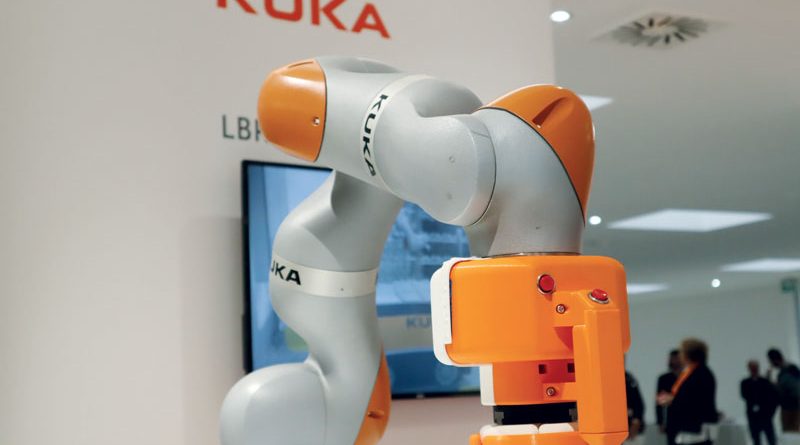Stories of Robots in Action
Not only collaborative robots. Assembly-related applications were quite a hot topic on February 8th at KUKA’s headquarters in Grugliasco, where the first “Customer Stories” were held. An event organized with the aim of involving some of the top end users of robots and automation systems, who talked about motivations, feasibility and effects of concrete and sometimes surprising experiences.
by Fabrizio Dalle Nogare
“We operate in quite an interesting but difficult market at the same time. For this reason, companies need to have broad shoulders. The recent changes in the structure of our Group, with the acquisition by the Chinese multinational Midea, go in this direction. As an Italian subsidiary, we are proud to have been appointed as a Competence Center for EMEA (Europe and Middle East, ed) for TIER 1 in automotive since last year. For 2019 we have raised the bar, setting ourselves the goal of 60 million euro in turnover. The words of Gian Luca Branca, KUKA CEO, who together with Alberto Pellero (see box) introduced and moderated the event entitled “Customers Stories” in Grugliasco. A day in search of concreteness that, judging by the number of participants, has definitely hit the mark.
The “mobile” collaborative robot manages tightening operations in the assembly line
As one of the first customers to believe in the use of mobile and collaborative robotics in Italy, Lamborghini has taken the step in this direction driven by two primary needs: to meet, with the help of automation, the increase in orders generated by the introduction of the latest car models on the market and try to limit the amount of space devoted to production equipment within the plant. Matteo Martini, Head of Manufacturing Engineering Mechanics & Electronics at Lamborghini, explained how, with the support of Egicon, they managed to install a certified tightening system consisting of an AGV and an LBR iiwa collaborative robot, working in the so-called “marriage” station. This is where the assembly takes place between the powertrain unit and the body of the rear part of the car. With the help of the vision system to identify the position of the screws and with the operators supposed to oversee the process, the robot takes care of tightening activities, working 16 hours a day for 26 daily cycles overall. “For reasons of space and production volumes, it would not have been possible to use a traditional robotic system. The investment has also proved valuable in terms of image, to the benefit of those who visit our factories”, added Mr Martini.
An investment to handle with care
A benchmark in the supply of high-tech components and systems, Magneti Marelli must certainly be considered one of the top end users in automotive. Andrea Meda, Equipment Engineer at the Corbetta plant, spoke about the introduction of robotic solutions in the production and assembly lines of electronic tools for traditional, electric and hybrid cars.
“The Corbetta plant has decisively turned to robots, especially for new generation products to be applied to hybrid and electric vehicles”, explained Mr Meda. “Within our lines, six-axis and collaborative robots coexist and we are preparing training activities at various levels to make us autonomous in programming and managing the robots”.
The tasks devoted to KUKA robots – there are about 35 currently in use – include assembly, screwing, dispensing and dimensional inspection for products such as inverters and power modules. “We believe that investments in robots are important and need to be handled with care”, added Andrea Meda. “The feedbacks from the operators have been very positive so far: we see they wish to learn how to use robots”.
The key role of training
The issue of operators’ training is also dear to Philipp Holtewert, Global ME Automation Project Leader at Electrolux, a giant in the production of household appliances, as well as household and professional products. “The issue with introducing robots, especially the collaborative ones, is the operators’ lack of knowledge of their characteristics”, he said. “We do a lot of testing and training and plan to further implement the introduction of AGVs in combination with cobots”.
The small footprint and reduced wiring requirements are two other very important aspects for Electrolux, which currently uses KUKA robots in its Italian plants in marking and labelling applications, as well as in assembling dishwasher doors.
Six-axis robot for machine tools
Other field, different use of robots. The integrator Tecnosystem, since 2015 one of KUKA Official Partners, was among the first to use KUKA KR Agilus WP robots exploiting the mx Automation software to integrate and control the robots through external PLCs.
Several applications with six-axis robots inside the machine tools are currently working at the Italian factories of SKF, another Swedish company active in the production of components for motion transmission. “The robot allows us to significantly reduce the machine retooling time, thus carrying out several operations at the same time thanks to the easy retooling and the simplified communication with the CNC”, commented Roberto Prot, SKF. Working mainly in the aerospace and automotive industries, Belotti SpA, whose headquarters are in Suisio (BG), is specialized in 3- and 5-axis machining centres. Belotti Integrale is a two-storey work station for the machining of carbon and light alloys in which CNC-controlled six-axis robots are integrated. A KUKA QUANTEC KR 270 R2700 robot is at work on the lower floor, mounted on the ceiling to ensure a wide range of movement, performing machining operations, while on the upper floor a KUKA KR 30 robot managing three automatic warehouses and handles the right spindle to the robot. “Our Belotti Integrale system develops vertically to better integrate into existing production environments”, explained Fabrizio Pesenti, Project Engineer. “Currently the machine is installed in the Lamborghini factory and meets our customer’s requirements, such as high flexibility for modular production within a small workspace”.

